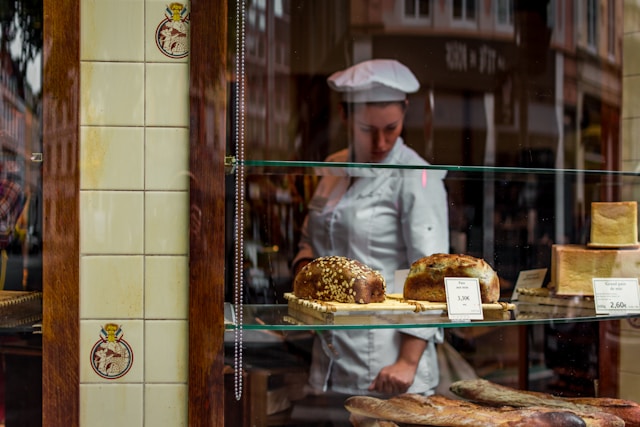Key Takeaways
- Visual appeal can significantly drive bakery sales and enhance customer experience.
- Display techniques should be carefully adapted to various baked goods and the targeted audience.
- An imaginative approach to display tactics can distinguish a bakery from the competition.
Table of Contents
- Introduction
- Crafting a Visual Feast: The Art of Display
- Bakery Display Essentials: Materials and Design
- Color Coordination: Engaging the Senses
- Strategic Placement: Traffic Flow and Impulse Buys
- Seasonal and Thematic Displays: Connecting with the Calendar
- Lighting: Creating Ambiance and Highlighting Products
- Maintenance: Keeping Displays Fresh and Inviting
- Customer Interaction: Encouraging Engagement
- Using Technology: Digital Displays and Social Media Integration
- Legal Considerations: Labeling and Compliance
Welcoming customers into a bakery is like inviting them to a treasure trove of sensory delights. The presentation of baked goods can be as impactful as their taste. A well-designed display, such as elegant refrigerated cases, is paramount in maintaining the freshness and allure of these delights. Bakeries must create an inviting atmosphere to draw customers in and encourage indulgence. Strategically considering every display aspect, from design to product placement, can provide a visual feast and enhance the shopping experience.
Crafting a Visual Feast: The Art of Display
A bakery’s display is crucial in attracting customers. A visually appealing design and thoughtful arrangement of baked goods can tell a story of care, quality, and artistry. A great display evokes emotion and can turn a casual browser into a loyal customer. It encourages interaction and curiosity and reflects the bakery’s commitment to quality.
Bakery Display Essentials: Materials and Design
When creating a bakery display, choose materials that reflect the bakery’s values. Glass cases offer a modern look, while wood provides a traditional feel. Materials should be practical and easy to maintain. The design should be functional and visually appealing. Use principles such as balance, symmetry, and focus. Strategic placement of shelves can guide customer movement and influence purchase decisions.
Color Coordination: Engaging the Senses
Scientific studies have shown that color can affect mood and even awaken hunger. In a bakery setting, this can be a powerful tool. A thoughtful color palette can complement baked goods, making them appear even more irresistible. For example, warm tones enhance the appeal of fresh, golden-brown pastries, while a burst of vibrant colors makes fruit toppings pop against a more neutral background. Color coordination extends to packaging and signage, harmonizing with the interior design to create a consistent and inviting brand experience.
Strategic Placement: Traffic Flow and Impulse Buys
A bakery’s layout is a guidebook for customers, subtly directing them where to go and what to try next. The strategic placement of items throughout the store can substantially affect sales, especially when it comes to impulse buys. By positioning high-margin or seasonal items in areas that see more foot traffic, such as near the cash register or along the queue line, bakeries can entice last-minute add-ons that boost revenue. Understanding customer flow through the bakery can help to place products strategically, ensuring maximum visibility and appeal.
Seasonal and Thematic Displays: Connecting with the Calendar
Seasonality can breathe new life into a bakery’s offerings. A bakery can align its products with consumer tendencies and interests by creating displays that harness the essence of various holidays or events. For example, a display exploding with red and green during the Christmas season or pastel hues in spring can draw customers into the festive spirit, increasing their desire to purchase themed offerings. Reflecting the calendar in your displays can foster a sense of connection and community, showing customers that the bakery is in tune with their lives and celebrations.
Lighting: Creating Ambiance and Highlighting Products
Lighting is a critical element in display design, impacting how products look and how customers feel when they step into the bakery. The proper lighting can make a cake glisten or a crusty loaf of bread seem even more inviting. Task lighting, such as spotlights, can draw attention to specific products, while ambient lighting adds to the store’s overall atmosphere, making it welcoming and comfortable. A balance between the two ensures that while products are highlighted, the environment remains pleasant and conducive to browsing and purchasing.
Maintenance: Keeping Displays Fresh and Inviting
Regular maintenance is a non-negotiable requirement to keep displays looking their best. This involves the hygiene aspect, where cleanliness is paramount to present fresh and safe-to-eat products, as well as the visual aspect of the display. Stale products, untidy arrangements, and worn signage can all detract from the customer experience. Ensuring that every display is meticulously cared for and that each product looks its absolute best is essential in creating and maintaining an inviting bakery atmosphere.
Customer Interaction: Encouraging Engagement
Displays are not meant to be static; they should invite interaction and connect with customers personally. By incorporating elements that encourage tactile engagement, such as samples or hands-on demonstrations, a bakery can transform its wares from mere commodities to experiences. These actions create memories, promote the purchase of a product, and return customers who are invested in the stories and experiences that the bakery provides.
Using Technology: Digital Displays and Social Media Integration
Embracing modern technology can add a dynamic layer to traditional bakery displays. Digital screens offer the flexibility of rotating content, including menu items, specials, and even social media feeds that feature customer interactions and reviews. This integration also makes a bakery reactive, updating real-time information to reflect stock levels, new arrivals, or upcoming events.
Legal Considerations: Labeling and Compliance
Adhering to the proper labeling and health codes is not just a legal requirement but a commitment to customer transparency. Accurate labeling includes information about ingredients, potential allergens, and pricing. Placing a priority on compliance minimizes the risk of health hazards and solidifies the bakery’s reputation as a trustworthy establishment. Understanding these regulations and ensuring all displays meet legal standards is a critical part of the behind-the-scenes work that goes into running a successful bakery.

